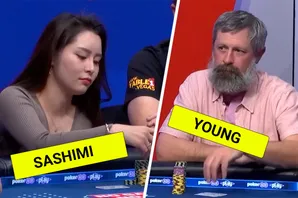In poker, a pair is when two of your cards have the same ranking, like two aces or two jacks. Two pair is when a player has two matching sets of cards in their hand.
For example, if your hand contains 10♣10❤️9♠9♦️Q♦️, then you have a pair of tens and a pair of nines, plus a queen as your fifth card. With two pair, the ranking of the cards is important to developing a strong hand, but suits are generally irrelevant.
In traditional poker games, poker players can build two pair by using the cards in their hand. In games like Texas Holdem and Omaha, players can arrive at two pair by using both their own cards and the community cards.
If you’re wondering about the likelihood of achieving two pair and how to best play your two-pair hand in your next poker game, then read on. We’ll cover all the important details, probabilities, and rankings for two-pair hands.
What is the probability of getting two pair in poker?
When drawing a five-card hand from a 52-card deck, your odds of drawing two pair in your starting hand are 20 to 1. The 4.7539% chance of achieving two pair off the bat aren’t very strong odds. So while you shouldn’t necessarily base your whole poker strategy on drawing two pair, it's still one of the easier hands to achieve in the game.
The odds of getting two pair in Texas Holdem are significantly better because you can use both your hole cards and the community cards to get your first and second pair. In Texas Holdem, the odds are 3.26 to 1 against getting two pair. That 23.5% chance is a big improvement over traditional five-card poker probabilities.
Ultimately, there are 858 different ways to make two pair with a 52-card deck, so whether you’re playing online poker, in a casino, or at home with friends, two pair is an achievable hand.
Two pair poker hand rankings
In terms of overall hand rankings, two pair isn’t a very strong hand, but it’s far from the weakest.
Two pair wins against a one-pair hand and a high-card hand. Two pair is a weaker hand than three of a kind, a straight, a flush, a full house, four of a kind, a straight flush, and a royal flush.
What happens if two players have two pair?
In a situation where you and another player both have two-pair hands, the rank depends on the cards that form each of your pairs and your kicker. Look at your highest ranking pair and your opponent’s highest ranking pair to see which hand is stronger.
If you and your opponent have the same high pair, then the ranking of your second pair is the determining factor. If you have two identical pairs, then the higher kicker card will determine the winner.
So if you have K♠K❤️5❤️5♦️10♣ and your opponent has K♣K♦️3❤️3♣J♦️, you’ll win. That’s because although you both have a pair of kings, your pair of fives rank higher than your opponent’s pair of threes.
If you both have a pair of jacks and a pair of nines but your kicker is a king and your opponent’s kicker is a 5, then you win because your hand ranks higher.
Playing two pair strategically
Playing your two-pair hand strategically depends on the cards you have and the particular poker variation you’re playing. Remember that it's always important to conceal the strength of your hand throughout the betting rounds.
Let’s say you’re dealt a pocket pair of aces as your hole cards in a game of Holdem. You know that you have a jump start on several hands including a single pair, two pair, three of a kind, full house, and four of a kind.
While you may want to bet aggressively because of what you’re holding, slow-playing with a more subdued bet may be a wiser choice to avoid scaring off other players. The larger the pot grows, the better.
In a game of Holdem, you also want to remember that any pair from the community cards is also available to the other players. While a pair on the table may give you your second pair, it could also give your opponents a second pair, three or four of a kind, or a full house.
Overall, it’s always better to work toward a hand with higher ranking pairs made up of face cards. If you’re holding two pairs made up of low ranking cards, you may want to bow out and try your luck in the next hand.
Featured image source: Flickr by Larry Kang used under CC license




























